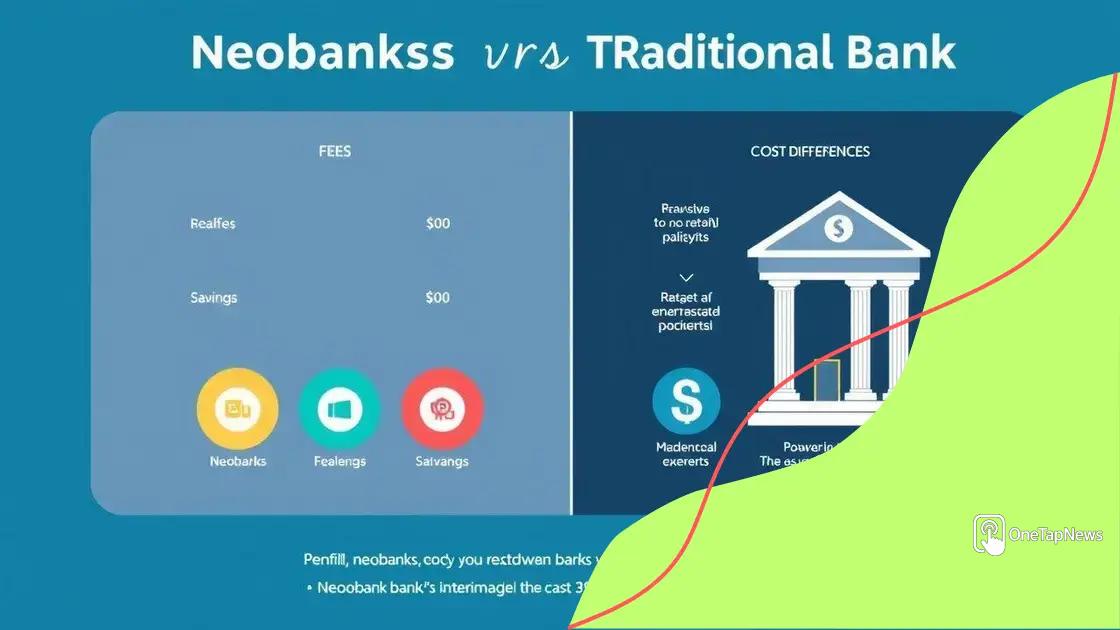Neobanks and traditional banks: what sets them apart?

Anúncios
Neobanks are digital-only banks that focus on convenience and lower fees, while traditional banks provide in-person services and a broader range of financial products, catering to different customer preferences.
Neobanks and traditional banks represent two very different approaches to managing your money today. With the digital era transforming finance, have you considered which banking style fits your lifestyle better?
Anúncios
Understanding neobanks and their rise
As the world becomes more digital, neobanks have risen to prominence, changing how we think about banking. Unlike traditional banks, these fully online financial institutions offer innovative services tailored for a tech-savvy audience.
One reason for the popularity of neobanks is their ease of use. Customers can conduct most transactions via mobile apps, making banking more accessible. This convenience has drawn many people away from traditional brick-and-mortar banks.
Key Features of Neobanks
Neobanks highlight several features that set them apart:
Anúncios
- Lower fees: Many neobanks offer no monthly fees, making banking affordable.
- User-friendly apps: Their applications provide a seamless user experience.
- Instant notifications: Customers receive immediate updates on transactions, enhancing financial awareness.
Moreover, neobanks cater specifically to younger generations who value flexibility and efficiency. As they integrate advanced technology, they appeal to a demographic that desires finance solutions at their fingertips.
The growth of neobanks can be attributed to a general frustration with traditional banking systems. Long wait times, hidden fees, and outdated technology discourage users. In contrast, neobanks prioritize transparency and speed, creating a loyal customer base.
Challenges Facing Neobanks
While neobanks are on the rise, they face their own set of challenges. Security is a major concern, as customers must trust these online-only banks with their financial information. Additionally, regulatory compliance can be complex for these newer institutions.
Despite these hurdles, the financial landscape is changing. Neobanks not only challenge traditional banks to innovate, but they also create a competitive atmosphere that ultimately benefits consumers. As they continue to grow, it’s clear that neobanks are here to stay, reshaping the future of banking.
Comparing services of neobanks and traditional banks
When looking at neobanks and traditional banks, there are clear differences in the services they offer. Understanding these differences can help you choose the best banking option for your needs.
Traditional banks have been around for decades. They provide services like checking and savings accounts, loans, and credit cards. However, their processes can be slow and often involve hidden fees. Neobanks, on the other hand, leverage technology to simplify banking. Most neobanks operate exclusively online, which allows for faster service and less overhead cost.
Service Features of Neobanks
Neobanks are known for several standout features:
- Instant account setup: Opening an account can take just a few minutes through an app.
- No monthly fees: Many neobanks don’t charge maintenance fees, making them cost-effective.
- User-friendly interfaces: Their apps are designed for ease of use, with intuitive navigation.
- Innovative tools: They often include budgeting tools and spending insights to help manage finances.
In contrast, traditional banks come with certain advantages. For instance, they offer physical branches where you can talk to a representative. This personal interaction can be helpful for complex financial matters. Additionally, traditional banks might provide a wider range of financial services, such as wealth management.
Another important consideration is accessibility. Neobanks are available 24/7 through mobile apps. This allows customers to manage their accounts anytime. Traditional banks may have limited hours, which can be inconvenient.
Customer Support Differences
Customer support is another area where these two types of banks differ significantly. Neobanks typically offer support through chat or email. This can lead to faster responses, but for some, it lacks the personal touch of speaking with someone directly. Traditional banks usually provide phone support and in-person assistance, which some customers prefer.
Overall, comparing the services of neobanks and traditional banks reveals key distinctions that cater to different customer preferences. As you evaluate your banking needs, consider how each type of bank can serve you best.
Cost differences between neobanks and traditional banks

When comparing neobanks and traditional banks, cost differences play a significant role in the decision-making process for customers. Each type of bank has its own fee structures and costs that can impact your wallet.
Traditional banks often come with various fees. These can include monthly maintenance fees, transaction fees, and withdrawal fees. Customers might find themselves paying for services that are otherwise free at neobanks. Neobanks, typically, have a different approach by minimizing or eliminating many of these fees.
Common Fees at Traditional Banks
Here are some typical fees you might encounter with traditional banks:
- Monthly account maintenance fees: These can range from $5 to $15.
- Overdraft fees: Customers may face penalties for insufficient funds, often around $35.
- ATM withdrawal fees: Using an ATM outside of their network might cost you $2 to $5 per transaction.
In contrast, neobanks generally prioritize cost savings for their users. Since they operate online without physical branches, they avoid many expenses incurred by traditional banks. This allows them to pass the savings onto customers. For instance, most neobanks offer:
Cost Advantages of Neobanks
- No monthly maintenance fees: Many neobanks do not charge these fees at all.
- Free ATM withdrawals: Customers can often withdraw cash for free at thousands of ATMs.
- Minimal transaction fees: Most transactions are either free or have very low fees.
As you can see, the financial landscape is shifting. With neobanks gaining popularity, many customers are looking for budgets that favor low-cost banking options. Understanding these cost differences can help you make informed decisions about which banking service suits you best.
Customer experience at neobanks vs traditional banks
The customer experience at neobanks and traditional banks can vary widely. Understanding these differences is key for anyone looking to choose the best banking option.
Neobanks focus on providing an entirely digital experience. Customers can open accounts, manage funds, and access customer support through user-friendly apps. This convenience is a huge draw for many users, especially for those who prefer to avoid visiting physical branches.
Advantages of Neobanks
Here are some key aspects of the customer experience at neobanks:
- Seamless account setup: Most neobanks allow users to create accounts in minutes, often requiring just a smartphone and an internet connection.
- Real-time notifications: Customers receive instant updates about transactions, keeping them informed about their financial activities.
- 24/7 accessibility: Support and banking services are available any time of day, making banking more flexible.
- User-centric design: Apps are designed with ease of use in mind, often featuring intuitive layouts and modern aesthetics.
On the flip side, traditional banks still serve many customers who appreciate the personal touch. While they may not offer the same speed or flexibility as neobanks, they provide services that some users find comforting.
Benefits of Traditional Banks
Here are some points related to the customer experience with traditional banks:
- Personal interaction: Customers can meet face-to-face with banking representatives to discuss needs and solutions.
- Variety of services: Many traditional banks offer a wide range of financial products, from loans to investment advice.
- Physical presence: For people who prefer in-person banking, traditional banks are readily available in communities.
Ultimately, whether you prefer a neobank or a traditional bank depends on your individual needs and preferences. While neobanks may excel in convenience and innovation, traditional banks offer personal service and a broader range of services. Each option has its own strengths that cater to different customer experiences.
The future of banking: neobanks and traditional banks
The future of banking is evolving as both neobanks and traditional banks adapt to new consumer needs and technological advancements. Understanding how these two banking models will coexist is essential for consumers and industry experts alike.
Neobanks are rapidly gaining popularity due to their modern technology and customer-centric approaches. By providing a fully digital experience, they cater to users who value convenience and speed in financial transactions. As technology continues to advance, neobanks are likely to integrate even more innovative features, such as automated savings and investment tools.
Trends Shaping Neobanks
Several trends are influencing the growth of neobanks:
- Increased demand for mobile banking: More people are opting for banking solutions that can be accessed from their smartphones.
- Focus on financial literacy: Neobanks often offer tools and resources to help customers better manage their finances.
- Enhanced security measures: As digital banking grows, so does the commitment to keeping customer data safe and secure.
Traditional banks are not standing still, however. They are beginning to adapt by incorporating digital services to stay competitive. Many are investing in technology to improve their online offerings and enhance the customer experience.
Adapting Traditional Banks
Here are a few ways traditional banks are evolving:
- Creating user-friendly apps: Many banks are redesigning their mobile apps to make them more intuitive and accessible.
- Embracing hybrid models: Some banks are offering both traditional services and neobank-like features, such as no-fee accounts.
- Fostering partnerships with fintech companies: Collaborating with technology firms can help traditional banks innovate quickly.
The future of banking will likely see a blend of both neobanks and traditional banks. Customers may choose to mix and match services from both types of institutions to get the best of both worlds. As the industry evolves, understanding the strengths and weaknesses of each model will help consumers make informed decisions about their financial futures.
FAQ – Frequently Asked Questions about Neobanks and Traditional Banks
What are neobanks and how do they differ from traditional banks?
Neobanks are digital-only banks that provide banking services through mobile apps, focusing on convenience and low fees. Traditional banks offer services at physical branches and often charge more fees.
What are the benefits of using a neobank?
Neobanks typically have lower fees, offer a seamless online experience, and provide tools for budgeting and financial management.
Are traditional banks disappearing due to neobanks?
Not necessarily. Traditional banks are adapting by integrating digital services but are still preferred by customers who value personal service.
How can I choose between a neobank and a traditional bank?
Consider your banking needs. If you value convenience and low costs, a neobank might be best. If you prefer in-person service and a wider range of products, a traditional bank may be a better fit.